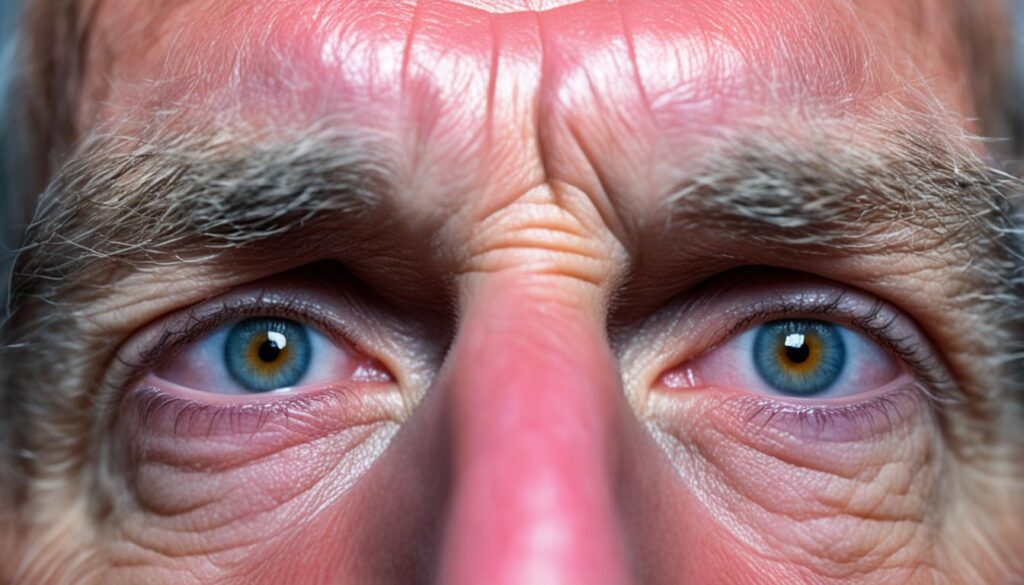Benign Essential Blepharospasm (BEB) is a neurological disorder that affects the muscles of the eyelids, causing involuntary contractions and spasms. It falls under the category of dystonia, which is a movement disorder. This condition primarily affects middle-aged and older women, and its symptoms can significantly impact daily life and quality of life. While the exact cause is unknown, researchers believe it may involve a combination of genetic and environmental factors. Diagnosis is made based on a clinical evaluation, history, and identification of characteristic symptoms.
Key Takeaways:
- Benign Essential Blepharospasm is a neurological disorder characterized by involuntary muscle contractions of the eyelids.
- This condition primarily affects middle-aged and older women.
- The exact cause of BEB is unknown, but it is believed to involve genetic and environmental factors.
- Diagnosis is made based on clinical evaluation, history, and identification of characteristic symptoms.
- Treatment options include botulinum toxin injections, medication, or surgery.
Table of Contents
ToggleWhat is Benign Essential Blepharospasm?
Benign Essential Blepharospasm (BEB) is a neurological disorder that causes involuntary muscle contractions and spasms of the eyelid. It is considered a form of dystonia, a movement disorder characterized by abnormal muscle contractions. The exact cause of BEB is unknown, but it is believed to involve dysfunction in the basal ganglia, a region of the brain involved in motor control. BEB can affect anyone, but it is more commonly seen in middle-aged and older women.
The symptoms of BEB include:
- Frequent blinking
- Eye irritation
- Difficulty keeping the eyelids open
- Sensitivity to light
- Functional blindness

Managing the symptoms of BEB and understanding its impact on daily life is crucial for individuals affected by this condition.
Causes and Risk Factors of Benign Essential Blepharospasm
The exact cause of benign essential blepharospasm (BEB) is unknown, but researchers believe it may involve a combination of genetic and environmental factors. Dysfunction in the basal ganglia, a region of the brain involved in motor control, is thought to play a role. Some risk factors for BEB include:
- A family history of dystonia or tremors
- Head or facial trauma
- Ocular irritation or diseases
- Certain medications used to treat other conditions
However, in most cases, BEB develops spontaneously with no known precipitating factor.
| Causes of Benign Essential Blepharospasm | Risk Factors for Benign Essential Blepharospasm |
|---|---|
| Genetic factors | Family history of dystonia or tremors |
| Environmental factors | Head or facial trauma |
| Dysfunction in the basal ganglia | Ocular irritation or diseases |
| Certain medications used to treat other conditions |
Symptoms and Diagnosis of Benign Essential Blepharospasm
The early symptoms of benign essential blepharospasm often include frequent blinking, eye irritation, and sensitivity to light. As the condition progresses, the spasms and contractions of the eyelid muscles become more frequent and forceful, sometimes leading to prolonged closure of the eyelids. This can result in functional blindness, although vision itself remains unaffected.
The diagnosis of benign essential blepharospasm is made based on a thorough clinical evaluation, history, and identification of characteristic symptoms. There are no specific laboratory tests to diagnose benign essential blepharospasm, so it is a clinical diagnosis.
| Symptoms of Benign Essential Blepharospasm | Diagnosis |
|---|---|
|
|

Treatment Options for Benign Essential Blepharospasm
The primary treatment for benign essential blepharospasm is periodic injection of botulinum toxin into the eyelid muscles. This weakens the muscles and reduces the spasms and contractions. The injections need to be repeated every few months to maintain the effect.
Medications such as anticholinergic drugs and dopamine depleters may also be used, but their effectiveness is usually moderate or unsatisfactory.
Surgical procedures, such as myectomy (removal of eyelid muscles) or neurectomy (cutting off nerve branches), may be considered for patients who do not respond well to other treatments. However, these procedures are usually reserved for severe cases.
Treatment Options Overview
| Treatment Option | Description |
|---|---|
| Botulinum toxin injections | Periodic injections weaken the eyelid muscles and reduce spasms and contractions |
| Medications | Anticholinergic drugs and dopamine depleters may be used with varying effectiveness |
| Myectomy | Surgical removal of eyelid muscles |
| Neurectomy | Surgical cutting off of nerve branches |

It is important to consult with a healthcare professional to determine the most appropriate treatment option for your specific condition. They can provide personalized guidance and help minimize the impact of benign essential blepharospasm on your daily life.
Clinical Trials for Benign Essential Blepharospasm
Clinical trials play a crucial role in enhancing our understanding of disorders and developing improved methods for detection, treatment, and prevention. Participating in clinical trials can provide valuable insights into benign essential blepharospasm (BEB) and potentially lead to the development of new treatment options for individuals affected by the condition.
If you have been diagnosed with BEB, you might consider participating in ongoing clinical trials to contribute to the advancement of knowledge in this field. These trials are designed to test the efficacy and safety of new interventions or study the effectiveness of existing treatments. By actively engaging in clinical trials, you can help researchers gain a deeper understanding of BEB and potentially discover more effective strategies for its management.
Various clinical trials dedicated to studying and treating BEB are currently underway. These trials aim to explore innovative treatment methods, evaluate the impact of different medications, or assess potential surgical interventions. By participating, you can contribute to the development of improved therapies that can enhance the lives of individuals with BEB.
If you are interested in participating in a BEB clinical trial, it is essential to gather all the relevant information before making a decision. Websites such as NIH Clinical Research Trials and You and ClinicalTrials.gov provide comprehensive databases of ongoing trials, including those specifically focused on BEB. These platforms offer valuable resources to help you understand the trial requirements, eligibility criteria, and potential benefits or risks of participation.
It is important to consult with your healthcare professional and carefully assess the suitability of a clinical trial for your specific condition and needs. They can provide expert guidance, address any concerns or questions you may have, and help you make an informed decision about participating in a BEB clinical trial.
Benefits of participating in clinical trials
Participating in a clinical trial for BEB can offer several benefits:
- Access to innovative treatments: Clinical trials often provide access to new and promising therapies that may not be available through standard treatment options.
- Contributing to research: By participating, you become an active contributor to scientific research, potentially paving the way for better understanding and management of BEB.
- Comprehensive medical care: Clinical trials typically involve close monitoring and comprehensive medical care, ensuring you receive the most appropriate and up-to-date treatment for your condition.
- Potential personal benefits: In some cases, clinical trial participants may experience improvements in their condition or symptoms as a result of the treatment being investigated.
Considerations for participation
Before deciding to participate in a BEB clinical trial, consider the following:
- Eligibility criteria: Each clinical trial has specific eligibility criteria that determine who can participate. It is important to carefully review these criteria to determine if you meet the requirements.
- Potential risks and side effects: Clinical trials involve certain risks and side effects that vary depending on the treatment being studied. It is important to understand these potential risks and weigh them against the potential benefits.
- Financial considerations: Some clinical trials may offer compensation for participation, while others may not. It is essential to understand the financial implications before committing to a trial.
- Time commitment: Participating in a clinical trial may require regular visits to the study site, additional tests or procedures, and a significant commitment of time. Ensure that you can accommodate the necessary time commitment before enrolling.
By carefully evaluating the benefits, risks, and considerations associated with participating in a clinical trial, you can make an informed decision about your involvement in advancing the understanding and treatment of BEB.
| Benefits of Participating in Clinical Trials for BEB | Considerations for Participation |
|---|---|
| – Access to innovative treatments | – Eligibility criteria |
| – Contribution to research | – Potential risks and side effects |
| – Comprehensive medical care | – Financial considerations |
| – Potential personal benefits | – Time commitment |

Living with Benign Essential Blepharospasm
Living with Benign Essential Blepharospasm (BEB) can significantly impact your daily life and quality of life. The frequent spasms and contractions of the eyelids can make it challenging to perform everyday tasks, such as reading, driving, and even keeping your eyes open. This neurological disorder can also cause emotional distress and social challenges due to the visible symptoms.
Tackling Everyday Challenges
Managing BEB in your everyday life requires a multifaceted approach involving medical treatment, lifestyle adjustments, and support from healthcare professionals. Here are some strategies to help you navigate the challenges of living with BEB:
- Medical treatment: Work closely with your doctor to determine the most suitable treatment plan for you. This may include periodic botulinum toxin injections to weaken the eyelid muscles and reduce spasms and contractions.
- Lifestyle adjustments: Make modifications to your daily routines to accommodate the difficulties caused by BEB. For example, you can try using magnifying glasses for reading or adjusting lighting to minimize sensitivity to light.
- Support groups: Connecting with others who have BEB can provide valuable emotional support and practical advice. Consider joining support groups or online forums where you can share experiences and learn from others.
- Healthcare professionals: Seek regular check-ups with your healthcare professionals to monitor your condition and discuss any concerns or changes in symptoms. They can provide guidance on managing BEB in various aspects of your life.
Remember, living with BEB requires patience and resilience. By seeking appropriate treatment, making necessary adjustments, and accessing support, you can effectively manage the impact of the condition on your everyday life.
Real-life Insights: Coping Strategies
Many individuals living with BEB have developed coping strategies to navigate their everyday life. Here are some insights from people who have firsthand experience:
| Coping Strategy | Insight |
|---|---|
| Reducing Eye Strain | Take frequent breaks to rest your eyes, blink consciously, and use artificial tears to alleviate dryness and irritation. |
| Disclosure and Education | Inform your family, friends, and colleagues about BEB to increase their understanding and support. Educate them on your condition and how they can assist you in different situations. |
| Mindfulness and Relaxation | Practice relaxation techniques such as meditation, deep breathing, or yoga to reduce stress and manage the emotional impact. |
| Assistive Devices | Explore assistive devices such as specialized glasses or eye patches to help manage symptoms and improve daily functioning. |
Remember that coping strategies vary from person to person, and it may take time to find what works best for you. Don’t hesitate to experiment, seek advice from healthcare professionals, and connect with others who share similar experiences.
Overall, living with Benign Essential Blepharospasm can be challenging, but with the right support and strategies in place, you can effectively manage the impact of this condition on your everyday life.
Resources for Benign Essential Blepharospasm
If you are seeking more information about benign essential blepharospasm, there are several reputable resources available to help you understand the condition and find support. Here are some recommended sources:
- Genetic and Rare Diseases Information Center (GARD): GARD provides comprehensive information about benign essential blepharospasm, including symptoms, causes, treatment options, and ongoing research. It serves as a valuable resource for individuals looking to learn more about the condition.
- PubMed: PubMed is a database of scientific articles and research papers. By searching for “benign essential blepharospasm” on PubMed, you can access a wealth of scholarly literature on the subject, which can deepen your understanding of the condition.
- NINDS Publication Catalog: The National Institute of Neurological Disorders and Stroke (NINDS) offers a publication catalog with printed materials on various neurological disorders, including benign essential blepharospasm. These materials are available free of charge and can be ordered online or downloaded as PDFs.
In addition to these resources, it may be beneficial to consult with healthcare professionals who specialize in movement disorders. They can provide personalized guidance and answer any specific questions you may have.
Connecting with others who have experienced similar challenges can also be helpful. Consider joining support groups or participating in online forums where you can share your experiences and learn from others in the community.
Comparison of Resources for Benign Essential Blepharospasm
| Resource | Key Features |
|---|---|
| Genetic and Rare Diseases Information Center (GARD) | Comprehensive information on symptoms, causes, treatment options, and ongoing research |
| PubMed | Access to scientific articles and research papers for in-depth knowledge |
| NINDS Publication Catalog | Free printed materials on neurological disorders, including benign essential blepharospasm |
By utilizing these resources, you can gain a better understanding of benign essential blepharospasm and find the information and support you need to manage the condition effectively.

Future Research and Developments for Benign Essential Blepharospasm
Future research in the field of benign essential blepharospasm aims to further our understanding of the condition’s underlying mechanisms and develop more effective treatments. Ongoing studies are exploring potential genetic and environmental factors contributing to benign essential blepharospasm. Additionally, research is focused on improving the delivery of botulinum toxin injections, developing novel medications, and investigating alternative treatment approaches. It is hoped that continued research efforts will lead to advancements in the diagnosis, management, and overall care of individuals with benign essential blepharospasm.
In order to tackle the challenges associated with benign essential blepharospasm, researchers are investing significant efforts in understanding the underlying causes and risk factors. Some of the key areas of future research include:
- Identifying specific genetic markers associated with the development of benign essential blepharospasm.
- Investigating the role of environmental factors, such as exposure to toxins or trauma, in triggering the condition.
- Developing new techniques for the precise delivery of botulinum toxin injections to target the affected eyelid muscles more effectively.
- Exploring alternative treatment approaches, such as the use of non-invasive therapies or neurostimulation techniques.
By gaining a deeper understanding of the mechanisms behind benign essential blepharospasm and developing innovative treatment approaches, researchers hope to improve the quality of life for individuals living with this condition. Future research endeavors have the potential to revolutionize the diagnosis, management, and care of individuals with benign essential blepharospasm, offering new hope and possibilities for those affected by the disorder.
Conclusion
Benign Essential Blepharospasm is a neurological disorder characterized by involuntary muscle contractions and spasms of the eyelid. Although the exact cause of this condition is unknown, there are various treatment options available to manage the symptoms of BEB. These include botulinum toxin injections, medications, and surgical procedures.
For individuals living with BEB, it is essential to work closely with healthcare professionals to determine the most suitable treatment approach. By seeking support from available resources and exploring different treatment options, individuals can effectively manage the impact of BEB on their everyday life.
Ongoing research and clinical trials offer hope for further understanding and advancements in the field of BEB. Continued efforts in research aim to uncover the underlying mechanisms of the condition and develop more effective treatments. By participating in clinical trials, individuals with BEB can contribute to the advancement of knowledge and potentially benefit from new treatment options in the future.
FAQ
What is benign essential blepharospasm?
Benign essential blepharospasm is a neurological disorder characterized by involuntary muscle contractions and spasms of the eyelid. It is considered a form of dystonia, a movement disorder.
What are the causes and risk factors of benign essential blepharospasm?
The exact cause of benign essential blepharospasm is unknown, but it is believed to involve dysfunction in the basal ganglia, a region of the brain involved in motor control. Some risk factors include a family history of dystonia or tremors, head or facial trauma, ocular irritation or diseases, and certain medications.
What are the symptoms and how is benign essential blepharospasm diagnosed?
The symptoms of benign essential blepharospasm include frequent blinking, eye irritation, difficulty keeping the eyelids open, sensitivity to light, and functional blindness. The diagnosis is made based on a thorough clinical evaluation, history, and identification of characteristic symptoms. There are no specific laboratory tests to diagnose it.
What are the treatment options for benign essential blepharospasm?
The primary treatment for benign essential blepharospasm is periodic injection of botulinum toxin into the eyelid muscles. Medications and surgical procedures may also be considered for severe cases.
Are there any ongoing clinical trials for benign essential blepharospasm?
Yes, there are ongoing clinical trials that aim to improve our understanding of the disorder and develop new treatment options. Individuals with benign essential blepharospasm can consider participating in these trials to contribute to the advancement of knowledge in this field.
How does benign essential blepharospasm impact daily life?
Benign essential blepharospasm can significantly impact daily life and quality of life. It can make it challenging to perform everyday tasks and can cause emotional distress and social challenges due to the visible symptoms.
Where can I find additional resources for benign essential blepharospasm?
You can find additional resources from reputable sources such as the Genetic and Rare Diseases Information Center (GARD) and PubMed. The NINDS Publication Catalog also offers printed materials on neurological disorders, including benign essential blepharospasm, which are free of charge and can be ordered online or downloaded as PDFs.
What is the future research and development for benign essential blepharospasm?
Future research aims to further our understanding of the condition’s underlying mechanisms and develop more effective treatments. Ongoing studies are exploring potential genetic and environmental factors contributing to benign essential blepharospasm.
Source Links
About The Author

This article is medically reviewed by Dr. Chandril Chugh, Board-Certified Neurologist, providing expert insights and reliable health information.
Dr. Chandril Chugh is a U.S.-trained neurologist with over a decade of experience. Known for his compassionate care, he specializes in treating neurological conditions such as migraines, epilepsy, and Parkinson’s disease. Dr. Chugh is highly regarded for his patient-centered approach and dedication to providing personalized care.
→ Book a consultation to discover which remedies suit your needs best.




